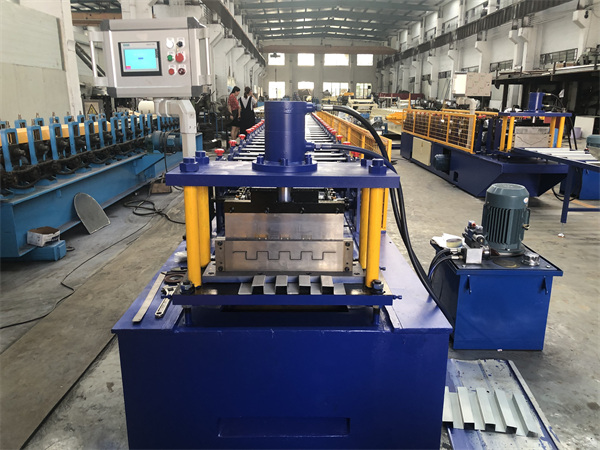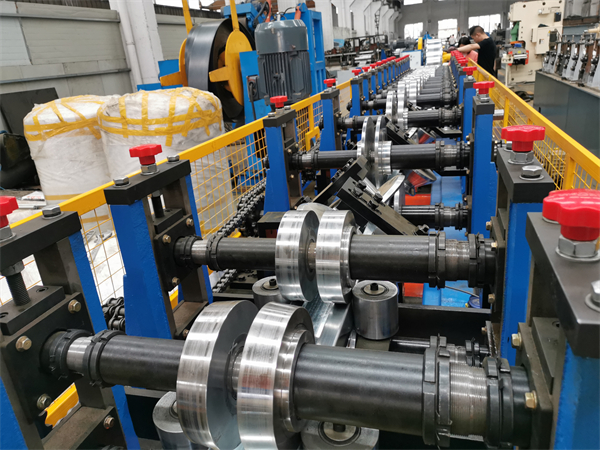Corrugated steel panel roll forming machines are used to produce corrugated steel panels for various applications such as roofing, wall cladding, partitions, silos, sheds, and more. These machines form the corrugated shape and required profile on metal coil strips through a series of rollers. The ribbed corrugated shape provides excellent structural strength and rigidity to the steel panels.
Corrugated steel panels provide durability, customizability, cost-effectiveness, weather-resistance, fire resistance, acoustic insulation, and quick installation. They are utilized extensively in industrial, commercial, infrastructural, and residential building construction for wall cladding, roofing, interior partition, ceiling, flooring, and decking applications.
The main components of corrugated steel panel roll forming machines include an uncoiler or de-coiler, feeding mechanism, forming and cutting section with roller dies, hydraulic system, PLC control system, and the exit table. Modern corrugated panel forming lines are fully automated with high production speeds and superior precision.
This guide covers the types, working principles, components, specifications, cost factors, suppliers, applications, advantages and limitations of corrugated steel panel roll forming equipment. It aims to help machinery buyers and engineers select optimal roll former configurations and suppliers for their production needs and budget.
Types of Corrugated Steel Panel Roll Forming Machines
| Machine Type | विवरण |
|---|---|
| Single Layer Roll Formers | Produce panels with single layer corrugated profiles like sinusoidal, trapezoidal, rounded etc. Lower capacity and lower cost machines. |
| Double Layer Roll Formers | Produce double-layer corrugated panels with higher strength. Two sheets are corrugated simultaneously with a flat sheet in between. Higher capacity. |
| Custom Profile Roll Formers | Highly customizable machines to produce panels with special profiles like box-ribbed, dovetail corrugated, multi-rib, etc. as per requirement. |
| Mobile Roll Forming Machines | Compact portable roll forming machines which can be moved near construction sites. Lower speeds and capacities. |
| Aluminum Corrugated Panel Machines | Designed specifically for soft and flexible aluminum coils. Include features like automatic oiling, edge rollers, etc. |
| Color Coated Steel Panel Machines | Additional UV curing stations to coat color on prepainted steel coils before roll forming. |

Working Principle of Corrugated Panel Roll Forming
Corrugated steel panel production through roll forming involves unwinding a flat metal sheet or coil strip, passing it through a series of roller dies to bend it into the ribbed corrugated shape, and cutting the panels to required length.
The working stages are:
- Decoiling – The plain galvanized steel coil is loaded on an uncoiler which unwinds and feeds the strip through the infeed guides.
- Feeding – The sheet is gripped by caterpillar feed rollers which pull the strip through the machine at a constant speed.
- Pre-forming – The strip passes through a straightening machine and initial pre-forming rollers to start bend formation.
- Forming – In the main roll forming section, the sheet passes through a series of roller dies which bend the strip incrementally to form the corrugated profile.
- काट रहा है – After achieving the final corrugated shape, the formed strip moves to the cutoff press which shears the panels at desired lengths.
- Counting – Panel counting sensors after the cutoff to count cut panels stacked on the exit table.
- Stacking – Formed panels are collected on the exit conveyor table for manual or automated stacking.
Main Components of Corrugated Steel Panel Roll Forming Lines
| Component | विवरण |
|---|---|
| Decoiler/Uncoiler | Releases the plain metal coil and feeds into the roll former |
| Feeding System | Grips and feeds the strip at constant speed through the machine |
| Pre-forming Rollers | Begins the initial shaping of the flat strip |
| Forming Stations | Series of roller dies which bend the strip incrementally to form the ribbed profile |
| Hydraulic System | Provides power for the presses and cutoff operation |
| PLC Control | Automated computerized control of machine parameters and production |
| Cutoff Press | Shears the formed panels at set lengths |
| Exit Conveyor Table | Collects the finished cut panels stacked inline |
Specifications of Corrugated Steel Panel Roll Forming Machines
| पैरामीटर | Typical Range |
|---|---|
| रोलर सामग्री | Alloy steel, hard chromium plated |
| Roller Diameter | 100-250 mm |
| Roller Type | Convex-concave form rollers in pairs |
| Number of Stations | 16-24 Stations |
| बनाने की गति | 5-15 m/min |
| Sheet Thickness | 0.15 mm – 1.2 mm |
| Sheet Width | 1000 mm – 1250 mm |
| Cut Length | 500 mm – 10000 mm |
| उत्पादन क्षमता | 300 – 1000 panels per shift |
Design Factors for Corrugated Panel Roll Formers
- Profile shape – Sinusoidal, rounded, angular, box/dovetail type ribs
- Number of corrugations per meter/inch
- Rib height – Higher rib provides greater strength
- Metal thickness – Thicker coils allow deeper profiles
- Sheet width – Wider coils need higher forming power
- Cut length – Longer panels may need support rollers
- Type of steel – Galvanized, prepainted, stainless, aluminum
- End product application – Roofing, walls, flooring, silos etc.
The machine has to be designed specifically based on these parameters to achieve the required corrugated profile dimensions accurately.
Installation and Operation of Corrugated Steel Panel Roll Forming Equipment
| Activity | विवरण |
|---|---|
| Site Preparation | Level concrete or steel foundation with space for unwinding coils and collecting panels |
| Positioning | Ensure proper infeed-forming-cutoff-outfeed flow path orientation |
| Power Supply | Connect electric supply and control cables to control panel |
| Trial Runs | Test with dummy coils, set speeds, profiles and tolerances |
| Coil Loading | Use overhead crane or forklift to load coils on decoiler |
| Parameter Setting | Input control parameters like speed, length, counts etc via PLC |
| Corrugated Panel Production | Monitor forming quality and stack finished panels |
| Maintenance | Regularly lubricate, inspect rollers, hydraulics, sensors etc |
Proper machine installation, trial runs and maintenance helps achieve high uptime and maximum corrugated panel production.
Cost Factors for Corrugated Steel Panel Roll Forming Machines
| Cost Factor | विवरण |
|---|---|
| Capital Cost | Higher for machines with more forming stations, automated features |
| Roll Tooling Cost | More complex profiles require more precision machined roll dies |
| Running Cost | Includes labor, power, coil material, maintenance |
| Production Cost Per Square Meter | Varies based on capital cost, operating cost and production speed |
Capital cost for standard corrugated panel roll forming lines starts around USD 40,000 and goes up based on tonnage, automation features and optional accessories.
Optimizing the specifications as per production needs gives the most economical corrugated panel roll forming line.
Major Corrugated Steel Panel Roll Forming Machine Manufacturers and Suppliers
| Company | Location | Machine Types |
|---|---|---|
| Eagle Bending Machines | US | Box rib, trapezoidal profile machines |
| LLC | Russia | High speed double layer corrugated machines |
| Metform | Turkey | Robust heavy-duty corrugated roll formers |
| Gasparini | इटली | Aluminum corrugated panel roll forming lines |
| Bradbury Group | UK | Mobile and portable roll forming equipment |
| SamCO Machinery | China | Economical standard corrugated machines |
Reputed manufacturers offer customized corrugated panel roll forming solutions as per application requirements.
How to Select Suppliers for Corrugated Steel Panel Roll Forming Equipment?
| पैरामीटर | Criteria |
|---|---|
| Machine Speed and Capacity | Match production output needed |
| Roll Forming Stations | More stations for complex profiles |
| Sheet Size Compatibility | Coil width and thickness handling capacity |
| Automated vs Manual | Level of automation features as per budget |
| Roller Material and Hardening | Abrasion-resistant and durable |
| Custom Profile Flexibility | Capability to produce special profiles |
| After Sales Service Quality | Machine installation support, maintenance training, spare parts supply |
| Local Partner Proximity | For coordination and technical support |
| Pricing and Payment Terms | Competitive pricing and flexible payment options |
Choosing reputed manufacturers with proven roll forming experience provides assurance of high machine performance, quality and durability.

Applications and Uses of Corrugated Steel Panels from Roll Forming Lines
| आवेदन | Panel Types Used |
|---|---|
| Roofing | Trapezoidal, rounded corrugated sheets |
| Wall Cladding | Sinusoidal, dovetail ribbed sheets |
| Interior Partition | Narrow width single layer corrugated sheets |
| Siloes and Hoppers | Angular corrugated sheets for strength |
| Flooring | Deeper corrugation sheets with understructures |
| Culverts | pipe arches made of curved corrugated metal |
Corrugated steel provides excellent protection from weather elements owing to its ribbed section strength. Panels are customized to suit usage – roofing needs wider ribs than walling.
Advantages of Using Corrugated Steel Panels
- High strength to weight ratio
- Quick and easy installation
- Design flexibility for creative profiles
- Corrosion resistance with coatings
- Fire resistance rating for partitions
- Acoustic insulation properties
- Abrasion resistance and impact protection
- Lower maintenance than other claddings
- Long service life up to 50 years
- 100% recyclable at end of life

Limitations of Corrugated Steel Panels
- Comparatively lower aesthetics than other finishes
- Prone to denting by impact loads
- Acoustic properties could be improved
- Needs understructures and interior finishes
- Not suitable for high humidity environments
- Difficulty in creating complex non-linear shapes
Proper design considering the advantages and limitations ensures the corrugated steel panels serve their purpose optimally.
निष्कर्ष
Corrugated steel panel roll forming lines enable efficient mass production of weatherproof, durable, lightweight and sustainable metal panels for infrastructure and construction needs.
Carefully designed machines with optimal specifications, properly manufactured high-quality roll tooling, precise process control and regular maintenance provides years of trouble-free operation and low cost per panel production.
Reputed manufactures provide customized corrugated profile roll forming solutions to suit small scale plants to high volume industrial facilities by expert configuration of uncoilers, feeding, pre-forming, profile roll stands, cutting and stacking systems.
सामान्य प्रश्न
Q: What sheet metal thickness is suitable for corrugated panels?
A: 0.4 mm to 1 mm thick galvanized steel coils are commonly used. Up to 1.5mm sheets can be corrugated for extra strength. For aluminum, 0.7 mm to 1 mm sheets are ideal.
Q: What is the difference between box rib and trapezoidal corrugated profiles?
A: Box rib profiles have four flat sides for each rib giving higher bending strength. Trapezoidal profiles have inclined rib side walls which provide higher shear strength.
Q: How are prepainted color coated sheets formed into corrugated panels?
A: Additional UV paint curing stations are incorporated in the roll former above the final forming stands for the color coating.
Q: What are the maintenance best practices for corrugated panel machines?
A: Regular lubrication of rollers, inspection of sensors and hydraulics, monitoring belt tensions and machine alignment ensures optimal performance.
Q: How can production speed be increased in roll forming lines?
A: Use higher power AC vector drives, minimize roller friction, reduce number of passes, use high strength and thin sheets to increase corrugated panel production speed.
Q: How to reduce noise levels in corrugated roll forming machines?
A: Use noise damping materials on covers, reduce panel vibration, use resilent rubber rollers, minimize friction, and lubricate moving parts regularly.
